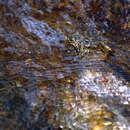Biology
provided by Arkive
A relatively sedentary species, Angel's Madagascar frog spends the majority of the time perched on a rock or boulder nearby or within a turbulent stream. Nevertheless, when disturbed this species demonstrates impressive energy, leaping from its rocky refuge into the water and skittering along the surface before clambering out onto another emergent object (2). Angel's Madagascar frog generally commences activity at dusk, or occasionally in the late afternoon, continuing throughout the night (2) (3). During this time it hunts for insects, small freshwater crustaceans and smaller frogs, devouring its prey whole. Although Angel's Madagascar frog is active throughout the year, its growth slows during the dry season (March to September), when temperatures are lower and food is less abundant (4).
Like most other frogs, the life-cycle of Angel's Madagascar frog consists of an aquatic, gilled tadpole phase, and an air-breathing adult phase (2) (5). The female lays over 300 eggs, usually within a shallow pool on the surface of a rock, which are fertilised by the male and swell into a gelatinous mass. Once hatched, the tadpoles are believed to remain in the pool or enter the stream, where they eventually metamorphose into juvenile frogs (2). The male Angel's Madagascar frog reaches sexual maturity at about two years old, around a year earlier than the female. This is a useful reproductive strategy as it allows the females to reach a larger size, where they are capable of producing a greater amount of eggs (4). This species has a relatively long lifespan reaching up to seven years (2).
Conservation
provided by Arkive
While there are no known conservation measures specifically targeting Angel's Madagascar frog, it is found in two protected areas, the Andohahela and Midongy-du-Sud National Parks (1). Nevertheless, increased protection of this species' habitat, along with educational programs to inform local people of how best to manage the forests sustainably, are vital measures that must be implemented if Angel's Madagascar frog is to be conserved (6).
Angel's Madagascar frog is one of nearly 2,000 species of amphibian worldwide threatened with extinction. Having produced the comprehensive Global Amphibian Assessment, which assesses the conservation status of all known amphibian species, the IUCN is now working towards mitigating threats to these species through the creation of the Amphibian Action Conservation Plan (7) (8).
Description
provided by Arkive
With marbled greyish or greenish-brown upperparts, the large-bodied Angel's Madagascar frog is perfectly camouflaged amongst the mossy, granite rocks of its preferred habitat (2) (3). In contrast to the upperparts, the belly is white, with scattered dark spots becoming denser around the throat. The eyes are large and prominent with a golden or brownish-copper iris speckled with black, while the area around eye and upper lip is marked with whitish spots. The hind feet of Angel's Madagascar frog are fully webbed, and each digit has a swollen, white tip, enabling this species to cling to moist rocks amongst fast-flowing water. Interestingly, the external ear drum of Angel's Madagascar frog is much smaller than in most frog species and, in addition, it is not known to produce any vocalisations. This may reflect the fact that hearing is not a particularly important sense for this species, as it lives amidst the continuous, loud noise of rushing water (2).
Habitat
provided by Arkive
Angel's Madagascar frog is found in and around fast-flowing rocky streams within undisturbed, as well as degraded, areas of humid, mature forest (1), between elevations of 50 and 1,120 metres (2).
Range
provided by Arkive
Angel's Madagascar frog is endemic to Madagascar, where it is restricted to just five locations within an area of less than 500 square kilometres in the extreme south-east of the island (1).
Status
provided by Arkive
Classified as Endangered (EN) on the IUCN Red List (1).
Threats
provided by Arkive
Owing to its restricted range, Angel's Madagascar frog is highly vulnerable to the ongoing, large-scale degradation and destruction of forest that is occurring in south-east Madagascar. Although this species remains relatively abundant at some localities, a multitude of threats including expanding human settlements, agriculture, logging, livestock grazing, charcoal manufacture and the spread of invasive eucalyptus, are causing its population to decline. The pressures have already proven severe enough to cause local extinctions around Fort Dauphin, near the southern limit of this species' range. (1).

